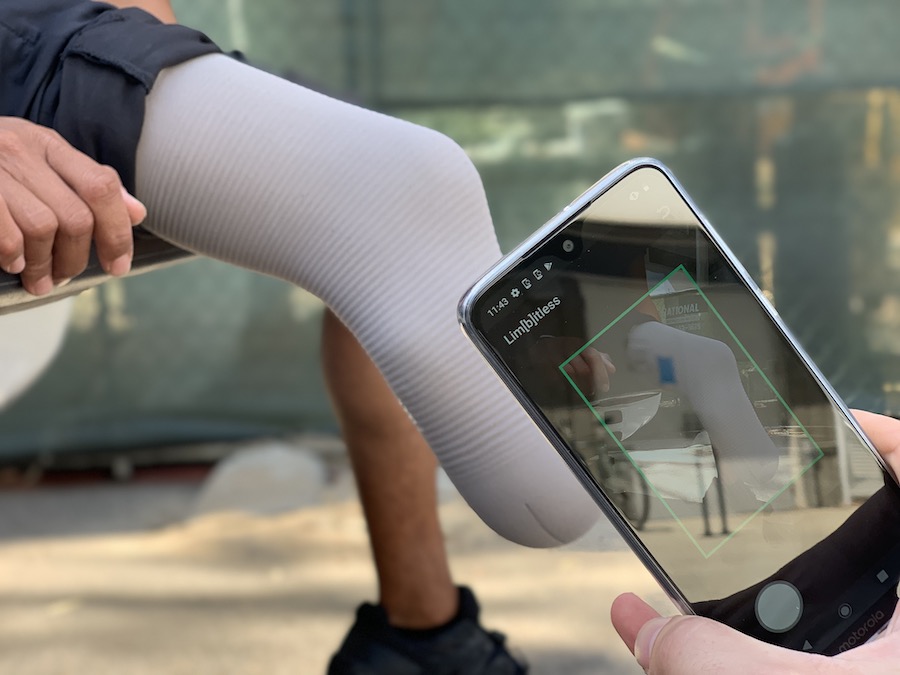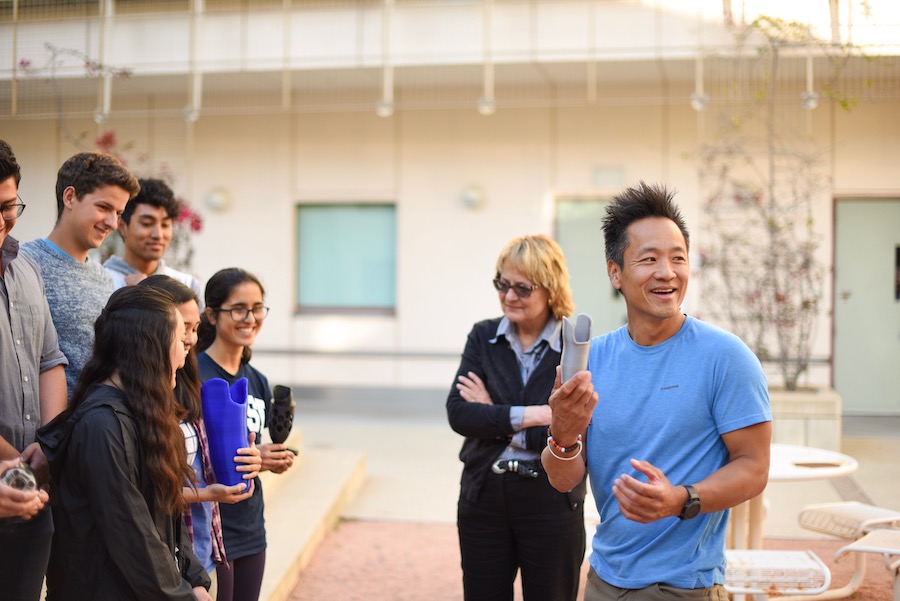
UC San Diego Researcher and Explorer Aims to Empower Amputees with 3D Printed Prosthetic Limbs
Albert Lin has launched "Project Lim[b]itless" to help the world's 40 million amputees who live without access to a prosthesis
Published Date
By:
- Xochitl Rojas-Rocha
Share This:
Article Content
Today, the majority of the world’s 40 million amputees live without access to a prosthesis. Albert Lin, a materials scientist and researcher with the Qualcomm Institute (QI) at UC San Diego, has created a project to change that.
With the help of students and multidisciplinary experts at QI, Lin launched “Project Lim[b]itless,” an initiative that leverages cellphone and 3D printing technology to significantly reduce the cost and time it takes to produce the custom sockets of a prosthetic limb. The team’s ultimate goal is to make prostheses more accessible, particularly for people in rural communities and developing countries.
For Lin, helping amputees regain their mobility and re-master the physicality of life is very personal. In 2016, he lost his right leg below the knee to a vehicle accident. With the help of state-of-the-art prosthetic shaping, Lin has been able to maintain an incredibly active lifestyle and pursue dream projects across the globe. He describes his ability to live fully as a privilege, one that too few amputees get to experience.

A cell phone scans Albert Lin's residual limb to create a digital, 3D model of his leg. The model will be used to build a custom-fitted socket and prosthesis that can be 3D printed.
“I feel this guilt for having access to a prosthetic that lets me have a full life when so many others don’t. So, in a way, I know I have this responsibility to take on the barriers to democratizing that access,” said Lin, director of the Center for Human Frontiers at QI.
From Snapshot to New Limb
Lin’s vision of empowering amputees across the globe begins by giving them direct access to a prosthetist through their cell phone. Today, amputees must find and travel to an expert for multiple fittings before they find the right fit for their lifestyle and mobility. For many, the demands on both time and money are insurmountable.
Project Lim[b]itless tackles these obstacles by giving patients the power to scan their residual limb anywhere in the world, and have their prosthesis delivered to them. The initiative employs a creative use of photogrammetry—an imaging technique that Lin has used to map historical sites in Mexico, China and Guatemala—to create a 3D model of someone’s limb using a cell phone app. All the amputee needs to do is snap photographs of their limb from different angles, and let the app recreate it digitally. The amputee can then electronically deliver the virtual model of their limb to a prosthetist, who will use cutting-edge software to design a comfortable, custom-fitted prosthesis. With 3D printing added in, a prosthesis takes fewer hours of human labor to produce, and the price drops significantly.
At QI, this ambitious project is being driven in part by graduate and undergraduate students. Isaac Cabrera, a Ph.D. candidate in Mechanical and Aerospace Engineering studying with Professor Joanna McKittrick (co-Principal Investigator on the project), heads a dedicated team that helps Lin tackle Project Lim[b]itless’ biggest engineering challenges.
“Additive manufacturing of prosthetics has the potential to directly impact millions of amputees around the world who have impaired mobility,” said Cabrera. “We’re taking on the responsibility to make sure that everything we build is quantifiably safe. We are eager to take on this challenge.”
Lin is tapping into his own background as a materials scientist to push the boundaries of prosthesis manufacturing to meet the unique lifestyles of each amputee his team supports. Some, like Lin, will need a prosthesis that can handle the stress of mountain climbing or hiking, or endure the highs and lows of extreme temperatures. 3D printing opens the doors to working with a variety of cost-effective materials—from recycled plastics to wood—that can withstand the physical demands of a variety of activities.
The Mind-Body Whole
Lin is complementing his work on Project Lim[b]itless with a unique treatment for amputees suffering from phantom limb pain. Following the loss of his own limb, Lin experienced intense, unrelenting pain, stemming from the sensation that his phantom limb had become trapped with its toes flexed toward his face.
After finding little relief from more common pain medications, Lin turned to renowned neuroscientist V.S. Ramachandran, Director of the Center for Brain and Cognition at UC San Diego, for aid. They discovered that combining psilocybin, a powerful psychedelic derived from certain species of mushrooms, with mirror-visual feedback, in which the patient uses a mirror to recreate their missing limb, reduced Lin’s pain long-term.
“Psilocybin basically increases the number of connections between your neurons and allows you to let go of your ego, the perception of the ‘self’ that includes your body,” Lin said. “I’m interested in finding out whether we can harness that more fluid state of mind to help amputees remap their body, and create a new sense of self without a phantom limb.”
The experience has prompted Lin to expand his research to determine whether the treatment that helped him return to daily life might someday provide relief for others. He is currently collaborating with a number of UCSD neuroscientists and pharmacologists to pursue clinical trials.
Working Toward the Future of 3D-Printed Prostheses
This month, Lin, QI Director and co-Principal Investigator Ramesh Rao, and Cabrera and other students from Project Lim[b]itless will share their work at the 2019 INK Conference in Jaisalmer, India. While abroad, the team will have a chance to meet and work in-person with the non-profits Jaipur Foot and the Sahaj network to reach the country’s approximately one million amputees. For many, especially those in rural areas, a high-quality prosthetic limb that fits exactly to their body and lifestyle isn’t an option.

Albert Lin (right) and the students of Project Lim[b]itless show off small-scale, 3D printed prosthetics.
“What we are hoping is that future collaborations will enable us to reach those in need, no matter where they are in the world,” said Rao. “The Qualcomm Institute is uniquely situated to do that. The research happening here is driven by diverse talents and perspectives. With the help of international collaborators, we can share Project Lim[b]itless’ unique solutions with the global community.”
Project Lim[b]itless is a collaboration between the Center for Human Frontiers at the Qualcomm Institute and multiple universities.
For more information on Project Lim[b]itless, visit the project webpage on the Center for Human Frontiers website.
Share This:
You May Also Like
Stay in the Know
Keep up with all the latest from UC San Diego. Subscribe to the newsletter today.


